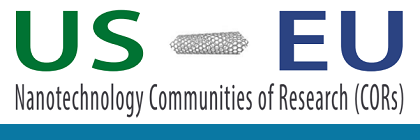Overview- NanoEHS CORS 2020 and 2022 workshops
The U.S.-EU NanoEHS CORs continue to be an active platform for transatlantic research collaboration. The 2020 NanoEHS COR virtual workshop sought to identify future needs and opportunities for collaboration across a maturing nanoEHS research community. Eight years of joint activities have forged a bridge between U.S. and European counterparts in the nanoEHS research community. The sense of community and bonds contributed to a productive conversation despite the virtual format. More than 185 attendees from diverse disciplines and backgrounds participated in the event, attesting to the interest in, and continuing relevance, of the transatlantic COR platform. With the theme, “Bridging Insights and perspectives,” the 2020 meeting extended the bridging theme that launched the CORs to sharing how lessons learned from nanoEHS research can and are being applied to other areas such as emerging technologies, incidental nanomaterials, and novel contaminants. The conversations sought a high-level, landscape consideration of nanoEHS and related areas, identifying the synergies necessary to drive responsible development in the coming decades. The COR themes that emerged from the discussions: (1)The nanoEHS  research infrastructure supports innovation and responsible development, (2) NanoEHS lessons are broadly applicable, and (3) the value in developing agile risk assessment and risk governance frameworks, and (4) the need for strategic programing in a maturing nanoEHS landscape The workshop archives can be viewed at http://tvworldwide.com/US-EU2020.
research infrastructure supports innovation and responsible development, (2) NanoEHS lessons are broadly applicable, and (3) the value in developing agile risk assessment and risk governance frameworks, and (4) the need for strategic programing in a maturing nanoEHS landscape The workshop archives can be viewed at http://tvworldwide.com/US-EU2020.
The CORs had their 10th meeting in June this year in Limassol. These previously mentioned themes continue to be focal areas. Key cross-disciplinary themes for the current and future directions of the CORs include (a) the use of the nanoEHS research infrastructure to tackle emerging contaminants and incidental nanomaterials, (b) sustaining the nanoinformatics and enhancing the data management literacy of the next-generation of nanoscientists, and (c) bridging the disconnect between environmental health and human Health.
Recent highlights and accomplishments
Databases and Computational Modeling for NanoEHS (Databases) COR
- EU-U.S. 2030 Roadmap (https://doi.org/10.5281/zenodo.1486012)
- Platforms for empirical nanoEHS data: NanoCommons, Duke University NanoInformatics Knowledge Commons (Amos et al. 2021 DOI: 10.1016/j.impact.2021.100331)
- Advancing the FAIR (Finable, Accessible, Interoperable, and Reusable) principles for nanoEHS data:
- Linking data (Karcher et al. 2018 DOI: 10.1016/j.impact.2017.11.002)
- Progress towards nanomaterial-specific identifiers for InChI, the IUPAC International Chemical Identifier (Lynch et al. 2022 DOI: 10.3390/nano10122493)
- Creation and maintenance of interoperable platforms.
- Advancing a common ontology (EnanoMapper).
- Creating community standards for the workflow capturing nanosafety metadata (Papadiamantis et al. 2020, DOI: 10.3390/nano10102033).
Risk Management and Risk Assessment CORs
- Co-chairs for the Risk Management CO gave several presentations in 2021 and 2022 on risk management of nanotechnology in food and agricultural systems and of exposure to diesel exhaust emissions.
- J Scott-Fordsmand et al. 2021. Bridging international approaches on environmental, health and safety aspects of nanotechnology. DOI: 10.1038/s41565-021-00912-5
Current and future focal areas
Databases COR:
- Training the next generation of nanoscientists- everyone should be data management and data science literate
- Tool development and automation
- Models need to cite sources
Characterization COR:
- Learn lessons from nanosafety studies
- Minimum level of reporting for publications on micro- and nanoplastic (MNP), including additives, adsorbing pollutants).
- Procurement and deposition of real-world samples
- Methods for robust reproducible characterization of pristine and aged MNP samples.
- Develop quantitative methods for exposure to MNP and Representative Test Material (RTM) Benchmark material/test material in the absence of ‘reference material standards; development of SOPs.
- Inventory of projects and other resources (CUSP webpage).
- Models for release and adsorption of pollutants, morphology.
- New challenges from 3D printers.
Ecotoxicology and Human Health CORS:
- Presentation to November 2022 SETAC North America on Improving Integration between US and EU on the nanotoxicity research.
- Working with EU and US groups, e.g. Duke University-led INFRAMES, DIAGONAL, NanoHarmony
- Developing training on One Health tbd with WGA Education NSC.
Exposure COR:
- Identifying the lessons from the “covid experience” with natural nanoparticles to inform communities about engineered nanoparticles.
- Indoor air exposure assessment.
